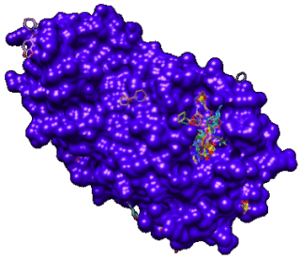Summary
The main protease (Mpro) in severe acute respiratory syndrome coronavirus 2 (SARS-CoV-2), the virus responsible for the coronavirus disease (COVID-19), has emerged as a promising drug target. The scientific community has produced a large number of crystallographic structures of the protease, which mediates viral replication and transcription. These structures report several fragments with varied chemotypes binding to different sites in Mpro. The main challenge at this stage is to effectively corroborate these valuable structural insights and expedite the search for any known drugs or natural products with properties similar to those fragments such that they can be rapidly translated for clinical testing against SARS-CoV-2. In this project, we build an artificial intelligence-based model using the available structural data of fragment-bound SARS-CoV-2 Mprocomplexes.Leveraging known drug-target interactions, our goal is to produce a machine learning algorithm capable of predicting potential drugs that can be repurposed for the treatment of COVID-19. We explore the potentials of small molecules, including drugs, natural products, and quantum dots to identify promising structures for inhibiting and/or detecting the SARS-CoV2 virus. Our results are expected to provide useful insights into the readily available therapeutic resources and help in the fight against the COVID-19 pandemic.
Related Content

A Reformulation of Quantum Game Theory
Summary Classical game theory – conducted at the interface between economics and computer science – has found applications in topics ranging from networking and security to online markets. Despite over 20 years of research into connections between game theory and quantum information, we have yet to see any significant implications of quantum information when applied […]
April 1, 2020

Quantum Simulations of Fundamental Interactions
Summary To address questions in modern physics such as “what is the structure of matter inside neutron stars?” we need better computational methods to evaluate the interplay of fundamental forces between elementary particles. To-date the response to such questions rests on numerical computer simulations that are inherently limited. In this project, we develop new theoretical […]
April 18, 2019

Topological Properties of Exciton-Polaritons in a Kagome Lattice as a Solid-state Quantum Simulator
Summary In this project, we build a solid-state quantum simulator for engineering a specific Hamiltonian. Quantum simulators are purpose-built devices with little to no need for error correction, thereby making this type of hardware less demanding than universal quantum computers. Our platform consists of exciton-polariton condensates in multiple quantum-wells sandwiched in a semiconductor Bragg […]
December 8, 2018



